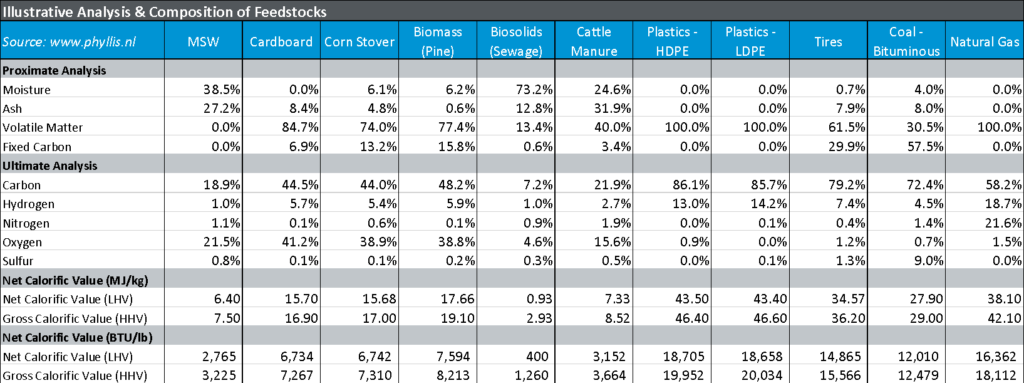Key Feedstock Consideration
Importance of Feedstock Composition
Feedstock composition may be the single most important factor in the safe and reliable operation of a processing facility. While systems can be optimized for specific feedstock composition, there are some general guidelines regarding the appropriateness of technologies for specific waste types. The selection of an optimal process technology also depends on the evaluation of multiple feedstock attributes such as the feedstock volumes, contract tenure, supplier creditworthiness, feedstock price, and feedstock variability.
Feedstock Properties
The makeup of the feedstock has a significant impact on how it will react both thermochemically and biochemically, and what products will result from each process. Proximate and ultimate analysis are two major methods for understanding the composition of the feedstock that offer distinct insights into the conversion potential.
- Proximate Analysis – The content of moisture, volatile matter, ash, and fixed carbon. More moisture requires more drying energy. Fuels with low volatile content can be more effectively processed by partial oxidation gasifiers whereas fuels with higher volatile content are better suited for indirect gasification.
- Ultimate Analysis – The elemental composition of the feedstock as a percent by weight of carbon, hydrogen, nitrogen, sulfur, oxygen, and other key elements. The elemental makeup will show how much energy can be produced by the feedstock in relation to the total of undesirable outputs like ash and pollutants.
Feedstock Content Analysis
The chemical makeup of the feedstock has a direct effect on how easily it can be converted into a target product. Factors like moisture, ash content, volatile versus fixed carbon, and the amount of each type of element, including carbon, hydrogen, nitrogen, and more will determine which process will yield the optimal end product.
Moisture
For most processes, the lower the moisture content the better, as water does not produce energy. On the contrary, it can take substantial quantities of energy to reduce the amount of moisture in a feedstock by drying it below a threshold of 30% in order for it to work in certain gasifiers and pyrolizers. 5-15% moisture content is an even better target. Untreated biosolids can have moistures of over 70% while corn stover is closer to 5-10%. A southern pine, when initially cut down can have a moisture content of around 50% but will dry out down to 20-30% after a month or more of being cut. Consistent moisture content in feedstock allows for lower variability in drying rates which allows for greater consistency in the feedstock processing systems.
Ash
The more ash in a feedstock, the less energy that feedstock will give off, but unlike water, ash can’t be dried out before processing. Instead, ash can be thought of as inorganic components like dirt and silica. If a feedstock has high ash content, it would likely be better suited for a fluidized bed gasifier since ash can turn into slag and damage or jam up the processes of downdraft gasifiers. Due to being in an oxygen-free environment, pyrolysis processes are indifferent to the amount of ash in a given feedstock in terms of processing and will generally not slag.
Volatile vs Fixed Carbon
The carbon in a feedstock can be considered either volatile or fixed. If it is volatile carbon, it can be substantially easier to free from its chemical bonds and convert into energy-producing syngas and other products. If the fixed carbon proportion is higher, it means that pulling the carbon out and converting it into other compounds will require gasification (a reducing environment) to maximize the carbon conversion. It may also require higher temperatures, longer retention times, and often different processes with higher CapEx.
Carbon, Hydrogen, and Oxygen
Carbon (C), hydrogen (H), and oxygen (O) are the main chemical elements that determine the heating value of fuels. The carbon content in biomass is typically higher (~45 %) than the hydrogen content (~6.0%) while the heating value of H is approximately seven times higher than that of C. The higher the ratio of hydrogen to carbon, the lower the oxidation state and the more energy that will be released during the oxidation reaction, which is shown by the C/H ratio.
The ratios of C, H, and O also determine the optimal products to be made from a given process. For example, hydrogen is valuable as it can be used to produce pure hydrogen (H2), which can be sold as a fuel for hydrogen vehicles or used in hydrolysis to upgrade certain liquids to drop-in biofuels. Hydrogen is also a critical component of methane (CH4) which is the principal natural gas used in heating and electricity production.
Carbon, the other key element present in methane (CH4), is a valuable component of syngas. Carbon can also combine with oxygen to produce CO, which is a syngas component of secondary value to CH4. Oxygen content in a feedstock can assist in the gasification process by reducing the amounts of pure oxygen or air needed to produce the syngas required.
Sulfur
Sulfur and other similar contaminants only degrade the process, reduce the overall energy content and result in undesirable pollutive emissions, including SOx, which may require expensive processes to eliminate or could result in permitting obstacles.
Nitrogen
Similar to sulfur, nitrogen levels in a biomass feedstock are not additive to the energy value and they contribute to NOx levels, which are considered pollutant emissions.

Overall Energy Content
The overall energy content of a feedstock is measured by its higher heating value (HHV) and lower heating value (LHV). The HHV is known as the gross calorific value and represents the amount of heat released when fuel is combusted. The LLV is known as the net calorific value and is calculated by subtracting the heat of vaporization of water vapor and ash content from the HHV, with HHV and LHV differing by the energy required to convert water from a liquid to a vapor. The higher the HHV, the more energy that will be produced by the internal compounds of a feedstock. In general, a feedstock will need to produce at least 4,000 BTU/pound in order to sustain the gasification or pyrolysis process. As shown in the chart above, typical biomass HHVs are in the 6,000 to 7,000 BTU/lb range while plastics can be more than double that at 18,000-20,000 BTU/pound. The values compare with the HHV of bituminous coal (12,000) and natural gas (16,000).
Join Nexus PMG in our mission to build a better world with waste-to-value projects.
- Anaerobic Digestion - July 23, 2020
- Key Feedstock Consideration - July 16, 2020
- Biomass Conversion Technology Overview - July 9, 2020


